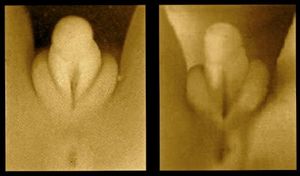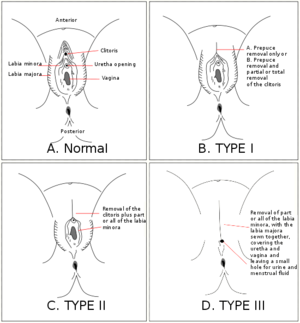Male and female circumcision

Contents
"Different"
There is a psychological divide between male and female circumcision. Advocates and opponents of male circumcision alike resent putting the cutting of both sexes in the same category. Various reasons are given as to why male and female circumcisions are "just not the same." Despite the great efforts that some people take to affirm the belief that male and female circumcision are "different," male and female circumcision are closer than people will care to acknowledge. Upon closer inspection one will find that a lot of the "reasons" people give are based in myth.
Not the same: reasons given
There are various reasons given as to why male and female circumcision belong in two separate categories:
- Female circumcision is worse than male circumcision.
- Female circumcision doesn't have health benefits like male circumcision does.
- Female circumcision eliminates the ability to orgasm, a circumcised man can still function.
- Female circumcision is performed to subjugate a woman and purposefully diminish her sexuality.
- Female circumcision removes the clitoris, male circumcision doesn't remove anything important.
- Female circumcision is performed in unsanitary environments.
- Female circumcision is performed with unclean utensils.
- Female circumcision is performed by amateurs.
- Female circumcision is traumatic because it is performed on older girls and women.
- Female circumcision is performed without pain killers.
- Female circumcision involves risks and complications.
Genital mutilation: different sexes, same principle
Quite a few alibis are given as to why male and female circumcision must be placed in different articles, and they will be debunked and discussed at length in this article. However, before going any further, the common thread that binds male and female forced genital cutting will be presented, and it is this; forcefully cutting off part of the genitals of a healthy, non-consenting individual violates the exact same principle of genital integrity.
Different sexes, different cultures, same attitudes
The following chart highlights similarities in attitudes and misconceptions about MGM (male genital mutilation) in the United States and FGM (female genital mutilation) in Africa.
Comparison by Hanny Lightfoot-Klein, author of Secret Wounds
| Clitoridectomy and Infibulation in Africa | Infant Male Circumcision in the United States |
|---|---|
| "She loses only a little piece of the clitoris, just the part that protrudes. The girl does not miss it. She can still feel, after all. There is hardly any pain. Women's pain thresholds are so much higher than men's." | "It's only a little piece of skin. The baby does not feel any pain because his nervous system is not developed yet." |
| "The parts that are cut away are disgusting and hideous to look at. It is done for the beauty of the suture." | "An intact penis is a real turn-off. It's disgusting. It looks like the penis of an animal." |
| "Female circumcision protects the health of a woman. Infibulation prevents the uterus from falling out [uterine prolapse]. It keeps her smelling so sweet that her husband will be pleased. If it is not done, she will stink and get worms in her vagina." | "An intact penis causes urinary infections and penile cancer. It generates smegma and smegma stinks. A circumcised penis is more hygienic and oral sex with an intact penis is disgusting to women." |
| "An intact vulva is unclean and only the lowest prostitute would leave her daughter intact. No man would dream of marrying an unclean woman. He would be laughed at by everyone." | "An intact penis is dirty and only the lowest class of people with no concept of hygiene leave their boys intact." |
| "Leaving a girl intact endangers both her husband and her baby. If the baby's head touches the uncut clitoris during birth, the baby will be born hydrocephalic [excess cranial fluid]. The milk of the mother will become poisonous. If a man's penis touches a woman's clitoris he will become impotent." | "Men have an obligation to their wives to give up their foreskin. An intact penis will cause cervical cancer in women. It spreads disease." |
| "A circumcised woman is sexually more pleasing to her husband. The tighter she is sewn, the more pleasure he has." | "Circumcised men make better lovers because they have more staying power than intact men." |
| "All the women in the world are circumcised. It is something that must be done. If there is pain, then that is part of a woman's lot in life." | "Men in the 'civilized' world are circumcised." |
| "Doctors do it, so it must be a good thing." | "Doctors do it, so it must be a good thing." |
| Sudanese grandmother: "In some countries they only cut out the clitoris, but here we do it properly. We scrape our girls clean. If it is properly done, nothing is left, other than a scar. Everything has to be cut away." | My own father, a physician, speaking of ritual circumcision inflicted upon my son: "It is a good thing that I was here to preside. He had quite a long foreskin. I made sure that we gave him a good tight circumcision." |
| 35 year old Sudanese woman: "Yes, I have suffered from chronic pelvic infections and terrible pain for years now. You say that all if this is the result of my circumcision? But I was circumcised over 30 years ago! How can something that was done for me when I was four years old have anything to do with my health now?" | 35 years old American male: "I have lost nearly all interest in sex. You might say that I'm becoming impotent. I don't seem to have much sensation in my penis anymore, and it is becoming more and more difficult for me to reach orgasm. You say that this is the result of my circumcision? That doesn't make any sense. I was circumcised 35 years ago, when I was a little boy. How can that affect me in any way now?" |
What is being compared?
The statement "male and female circumcision are not the same" is a loaded statement, and misleading to say the least. It implies that there is only one, uniform kind of male circumcision, and only one, uniform kind of female circumcision. There are actually variations of genital cutting in either sex that can be placed upon a continuum. There are some forms of female genital cutting that are more severe than some forms of male genital cutting, and vice versa. There are also some forms of female genital cutting that are directly analogous to male circumcision.
Variations of male genital cutting
Male genital cutting can consist of a mere prick to draw a drop of blood, to cutting off just the tip of the foreskin, full excision of the foreskin, a procedure called subincision where the underside of the penis is cut lengthwise to expose the urethra, to a penectomy or shaft removal, castration or the removal of the testes, to the removal of the shaft and testes.
Variations of female genital cutting
FGC consists of several distinct procedures. Their severity is often viewed as dependent on how much genital tissue is cut away. The WHO—which uses the term Female Genital Mutilation (FGM)—divides the procedure into four major types[1] (see Diagram 1), although there is some debate as to whether all common forms of FGM fit into these four categories, as well as issues with the reliability of reported data.[2]
Type I
The WHO defines Type I FGM as the partial or total removal of the clitoris (clitoridectomy) and/or the prepuce (clitoral hood); see Diagram 1B. When it is important to distinguish between the variations of Type I cutting, the following subdivisions are proposed: Type Ia, removal of the clitoral hood or prepuce only; Type Ib, removal of the clitoris with the prepuce.[1]
Type II
The WHO's definition of Type II FGM is "partial or total removal of the clitoris and the labia minora, with or without excision of the labia majora. When it is important to distinguish between the major variations that have been documented, the following subdivisions are proposed: Type IIa, removal of the labia minora only; Type IIb, partial or total removal of the clitoris and the labia minora; Type IIc, partial or total removal of the clitoris, the labia minora and the labia majora.[1]
Type III: Infibulation with excision
The WHO defines Type III FGM as narrowing of the vaginal orifice with creation of a covering seal by cutting and repositioning the labia minora and/or the labia majora, with or without excision of the clitoris (infibulation)." It is the most extensive form of FGM, and accounts for about 10% of all FGM procedures described from Africa.[3] Infibulation is also known as "pharaonic circumcision".[4]
Type IV: other types
There are other forms of FGM, collectively referred to as Type IV, that may not involve tissue removal. The WHO defines Type IV FGM as "all other harmful procedures to the female genitalia for non-medical purposes, for example, pricking, piercing, incising, scraping and cauterization."[1] This includes a diverse range of practices, such as pricking the clitoris with needles, burning or scarring the genitals as well as ripping or tearing of the vagina.[1]
Mutilation vs. surgical procedure
Two factors make the difference between a mutilation and surgical procedure; medical necessity and/or informed consent. If there is no medical necessity, a procedure is still valid and acceptable if the recipient gives his or her full consent. This must happen in elective cosmetic surgery for example. When there is a medical necessity, but the patient is a minor, this decision must be left up to the minor's parents or guardians. The controversy in male circumcision is in that it is usually performed on a healthy, non-consenting minor where there is no medical necessity or clinical indication. Can a doctor perform non-medical surgery on a healthy, non-consenting child without a medical necessity or clinical indication, let alone give parents or guardians the option?
Children are neither in medical need of surgery, nor can they give their consent to elective cosmetic surgery.
References
- ↑ a b c d e
 (2008).
(2008). Eliminating Female Genital Mutilation – An interagency statement OHCHR, UNAIDS, UNDP, UNECA, UNESCO, UNFPA, UNHCR, UNICEF, UNIFEM, WHO
, Department of Reproductive Health and Research (RHR), World Health Organization. - ↑
 Elmusharaf S, Elhadi N, Almroth L. Reliability of self reported form of female genital mutilation and WHO classification: cross sectional study. BMJ. 15 July 2006; 333(7559): 124. PMID. PMC. DOI.
Elmusharaf S, Elhadi N, Almroth L. Reliability of self reported form of female genital mutilation and WHO classification: cross sectional study. BMJ. 15 July 2006; 333(7559): 124. PMID. PMC. DOI.
- ↑
 (1 June 2000).
(1 June 2000). Female genital mutilation
, World Health Organization. Retrieved 23 January 2008. - ↑ Frequently Asked Questions on Female Genital Mutilation (FGM)
